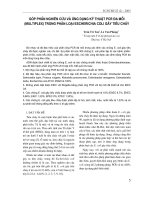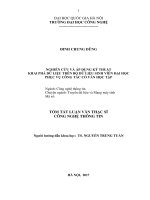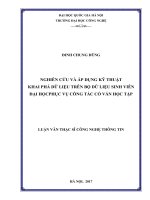Nghiên cứu và phát triển kỹ thuật chỗng nhiễu giao thoa trong bộ thu GNSS (research and development of advanced interference mitigation techniques in GNSS receivers)
Bạn đang xem bản rút gọn của tài liệu. Xem và tải ngay bản đầy đủ của tài liệu tại đây (2.8 MB, 63 trang )
MINISTRY OF EDUCATION AND TRAINING
HANOI UNIVERSITY OF SCIENCE AND TECHNOLOGY
--------------------------------------NGUYEN THI THANH TU
RESEARCH AND DEVELOPMENT OF
ADVANCED INTERFERENCE MITIGATION TECHNIQUES
IN GNSS RECEIVERS
MASTER OF SCIENCE THESIS
COMPUTER AND COMMUNICATION ENGINEERING
ACADEMIC SUPERVISORS:
1. Dr. Tạ Hải Tùng
2. Dr. Beatrice Motella
Hanoi – 2015
BỘ GIÁO DỤC VÀ ĐÀO TẠO
TRƯỜNG ĐẠI HỌC BÁCH KHOA HÀ NỘI
--------------------------------------NGUYỄN THỊ THANH TÚ
NGHIÊN CỨU VÀ PHÁT TRIỂN
KỸ THUẬT CHỐNG NHIỄU GIAO THOA
TRONG BỘ THU GNSS
LUẬN VĂN THẠC SĨ KHOA HỌC
KỸ THUẬT MÁY TÍNH VÀ TRUYỀN THÔNG
NGƯỜI HƯỚNG DẪN KHOA HỌC :
1. TS. Tạ Hải Tùng
2. TS. Beatrice Motella
Hà Nội – 2015
ACKNOWLEDGMENTS
In the first words of this thesis, I am extremely grateful to those who in various ways
contributed to all the results presented in this thesis.
Foremost, I would like to express my sincere gratitude to my supervisors Dr. Ta Hai
Tung and Dr. Beatrice Motella for their patience, encouragement, and broad research
vision. Their guidance helped me in all the time of this study and writing of this thesis.
In addition, I deeply acknowledge Prof. Gustavo Belforte for his enthusiastic supports.
I would like to thank the supports from all the NAVIS members. I am thankful to Tran
Trung Hieu, Nguyen Dinh Thuan, Truong Minh Duc, who gave me a lot of helpful
advice. I also appreciate Ms. Nguyen Thi Ha Phuong, who has always encouraged me
since the very beginning of my study.
The list could not be complete without the Growing NAVIS project, funded by the
European Commission under the FP7 Call Galileo.2011.4.3-1 – International Activities
(Grant Agreement No. 287203), for supporting my internship at ISMB from May to
July, 2013.
Last, and most importantly, I would like to thank my parents, my sister and her family
for their love that definitely is my limitless support.
3
COMMITMENT
I commit myself to be the person who was responsible for conducting this study. All
reference figures were extracted with clear derivation. The presented results are
truthful and have not published in any other person‟s work.
NGUYEN Thi Thanh Tu
TÓM TẮT LUẬN VĂN
Ngày nay, các hệ thống định vị toàn cầu sử dụng vệ tinh (GNSS – Global Navigation
Satelite System) đóng vai trò rất quan trong trong rất nhiều lĩnh vực khác nhau. Một số
ứng dụng GNSS dân sự quan trọng có thể kể đến như: giám sát các phương tiện giao
thông, đồng bộ trong truyền thông và bản đồ... Do đó, yêu cầu về tính chính xác và liên
tục đối với các bộ thu GNSS ngày càng trở nên cấp thiết.
Việc sử dụng kỹ thuật trải phổ trực tiếp, mang lại nhiều ưu điểm trong chống nhiễu cho
các hệ thống GNSS như GPS, Galileo. Tuy nhiên, các tín hiệu GNSS nhận được tại
antenna thường có năng lượng thấp, dẫn đến việc chúng dễ bị tác động bởi các nguồn
nhiễu khác nhau. Tất cả các tín hiệu được truyền trong phạm vi tần số gần với băng tần
tín hiệu GNSS đều có thể trở thành nguồn gây nhiễu cho bộ thu GNSS.
Có nhiều loại nhiễu khác nhau tác động lên bộ thu GNSS, trong đó, nhiễu băng hẹp
(narrow-band interference – NBI) là nhiễu có ảnh hưởng lớn nhất tới hiệu năng bộ thu
GNSS. Các nghiên cứu gần đây sử dụng Notch filter trong lọc nhiễu băng hẹp cho bộ
thu GNSS cho thấy đây là phương pháp khả thi và hiệu quả. Các bộ lọc notch filter đáp
ứng xung vô hạn có độ phức tạp không cao và có thể dễ dàng triển khai một cách và
hiệu quả.
Trong khuôn khổ luận văn, tác giả đề xuất một thiết kế mới cho khối chống nhiễu băng
hẹp trong bộ thu GNSS. Khối này có khả năng phân loại nhiễu băng hẹp và tự động
điều chỉnh cấu hình notch filter, sao cho chất lượng tín hiệu đầu ra đạt tốt nhất.
Luận văn được xây dựng gồm 5 chương như sau:
Chương 1. Fundamentals. Mô tả sơ lược về một hệ thống GNSS nói chung, và
nguyên tắc hoạt động của hệ thống. Trình bày các khái niệm liên quan đến nhiễu
(interference), ảnh hưởng của nhiễu lên hiệu năng bộ thu và tổng quan về các
phương pháp phòng chống.
Chương 2. Notch filter for GNSS narrowband interference mitigation. Giới
thiệu Notch filter, bộ lọc có khả năng loại bỏ nhiễu băng hẹp trong bộ thu
GNSS, các tham số quan trọng của Notch filter, và một cải tiến của Notch filter
giúp bộ lọc có khả năng tự phát hiện tần số của nhiễu băng hẹp.
5
Chương 3. New design of notch filters on GNSS narrowband interference
mitigation. Đề xuất một thiết kế mới của khối chống nhiễu băng hẹp trong bộ
thu GNSS.
Chương 4. Performance analysis. Trình bày các kết quả đánh giá đề xuất đã
nêu trong chương 3.
Chương 5. Conclusion. Tóm tắt nội dung luận văn, các kết quả đã đạt được.
TABLE OF CONTENTS
Acknowledgments ............................................................................................................ 3
Commitment ..................................................................................................................... 4
Tóm tắt Luận văn ............................................................................................................. 5
List of Figures .................................................................................................................. 9
List of Tables.................................................................................................................. 11
List of Abrreviations ...................................................................................................... 12
Introduction .................................................................................................................... 13
Chapter 1
1.1
Fundamentals ............................................................................................. 16
GNSS Overview ............................................................................................... 16
1.1.1
Fundamentals of satellite navigation ......................................................... 17
1.1.2
GNSS receiver structure ............................................................................ 19
1.2
Interference Threat ........................................................................................... 20
1.3
Interference Mitigation Techniques ................................................................. 23
Chapter 2
Notch Filter for GNSS Narrowband Interference Mitigation .................... 26
2.1
Notch Filter ....................................................................................................... 26
2.2
Adaptive Frequency Notch Filter ..................................................................... 28
2.3
Using Notch Filter on GNSS Narrowband Interference Mitigation................. 31
Chapter 3
New Design of Notch Filter
on GNSS Narrowband Interference
Mitigation 33
3.1
Impact of Notch Filter on GNSS Signal ........................................................... 33
7
3.2
New Design of Narrowband Interference Mitigation Module for GNSS
Receiver...................................................................................................................... 36
3.2.1
Interference Characterization Block .......................................................... 37
3.2.2
Notch Filter Configuration ........................................................................ 53
Chapter 4
Performance Analysis ................................................................................ 55
4.1
Bandwidth Estimation Algorithm..................................................................... 55
4.2
Quality of Filtered Signal ................................................................................. 57
Chapter 5
Conclusion ................................................................................................. 61
References ...................................................................................................................... 62
LIST OF FIGURES
Figure 1.1. Fundamental of a satellite navigation system .............................................. 17
Figure 1.2. Clock misalignments in a GNSS system ..................................................... 18
Figure 1.3. High-level architecture of a GNSS receiver ................................................ 19
Figure 2.1. Frequency response of notch filter for two difference pole factors............. 26
Figure 2.2. Spectrum at the front-end output at different time instants (from [4]) ........ 28
Figure 2.3. Power of filter output when notch frequency varies ................................... 29
Figure 2.4. Spectrum of an interfered signal before and after filtering ......................... 30
Figure 2.5. Adapted notch frequency of an ANF ........................................................... 31
Figure 2.6. High-level block diagram of the GNSS receiver chain ............................... 32
Figure 3.1. Proposed Interference Detection/ Estimation Unit ...................................... 37
Figure 3.2. Notch frequency varies ................................................................................ 38
Figure 3.3. Spectrum of the input signal ........................................................................ 40
Figure 3.4. The signal power at the output of a NF and its derivative. Bandwidth of NF
is fixed at 30 kHz and whose frequency sweeps over the spectrum range ................... 42
Figure 3.5. Bandwidth estimation algorithm ................................................................. 43
Figure 3.6. Interference bandwidth estimation for different NFs bandwidth ................ 45
Figure 3.7. Proposed method for characterizing the incoming NBI .............................. 46
Figure 3.8. The accuracy of the interference bandwidth estimation algorithm versus
........................................................................................................................................ 47
Figure 3.9. Notch frequency varies in the presence of a CWI ....................................... 48
Figure 3.10.
versus
.............................................................................................. 52
Figure 3.11. Zoom of Figure 3.10 .................................................................................. 52
Figure 4.1. Simulation results: estimation of the interference bandwidth (
) ........................................................................................................................ 55
9
Figure 4.2. Simulation results: estimation of the interference bandwidth (
)
........................................................................................................................................ 56
Figure 4.3. Estimated interference bandwidth over time, in case of variable band ....... 57
Figure 4.4. Theoretical and practical C/N0 when bandwidth of interference
(ACARS Harmonics) and
..................................................... 58
Figure 4.5. Theoretical and simulated C/N0 in case of CWI (
) ................................................................................... 59
LIST OF TABLES
Table 1.1. Interference threshold versus interference bandwidth for GPS receivers in
track mode [16] .............................................................................................................. 21
Table 1.2. Potential interference sources [6].................................................................. 22
Table 1.3 Possible interference mitigation techniques to a standard GPS receiver [17]
........................................................................................................................................ 24
Table 4.1. Performance of the proposed architecture in case of CWI. .......................... 60
Table 4.2. Performance of the proposed architecture in case of band-limited
interference. .................................................................................................................... 60
11
LIST OF ABRREVIATIONS
ACARS
Aircraft Communication Addressing and Reporting System
AGC
Automatic Gain Control
ANF
Adaptive Notch Filter
C/N0
Carrier to Noise density ratio
CWI
Continuous Wave Interference
DS-SS
Direct Sequence-Spread Spectrum
EGNOS
European Geostationary Navigation Overlay Service
FFT
Fast Fourier Transform
FIR
Finite Impulse Response
GNSS
Global Navigation Satellite System
ICB
Interference Classification Block
IF
Intermediate Frequency
IIR
Infinite Impulse Response
IRNSS
Indian Regional Navigation Satellite System
LMS
Least Mean Square
MSAS
Multi-functional Satellite Augmentation System
NBI
Narrow-band Interference
NCB
Notch Filter Configuration Block
NF
Notch Filter
QZSS
Quasi-Zenith Satellite System
RFI
Radio Frequency Interference
SNR
Signal to Noise Ratio
WAAS
Wide Area Augmentation System
WBI
Wide-band Interference
INTRODUCTION
Nowadays the Global Navigation Satellite Systems (GNSSes) play a fundamental role
in several fields, belonging to very different areas. Tracking of vehicles fleets (trains,
trucks, or vessels), synchronization of communications and energy distribution
networks, logistics, and mappings are examples of important civil applications. Within
this scenario, the requirements that GNSS receivers have to fulfill, both in terms of
accuracy and continuity, are becoming more and more stringent.
GNSS systems like GPS and Galileo are based on the Direct Sequence-Spread
Spectrum (DS-SS) technique, which intrinsically gives them a high level of robustness.
At the same time, it has to be considered that the satellite signals arrive at the receiver
antenna with an extremely low level of power. This makes them vulnerable to different
disturbances. All the system transmitting at carrier frequencies close to the band of
interest are potential sources of interference for a GNSS receiver. Even small leakages
out of their allocated bandwidth can become threats for the receiver.
Among many types of disturbances, narrow band interference (NBI) might cause
serious receiver performance degradation. Recently, notch filters, which pass all
frequencies except those in a narrow stop or rejection band centered on a central
frequency, have been considered as an effective technique for mitigating NBI. There
are several ways to implement a notch filter, among which the infinite impulse
response notch filter (IIR NF) has a low complexity and efficient implementation. In
this thesis, through the assessment of the carrier to noise density ratio of the filtered
signal, a new design of the interference mitigation module based on the IIR NF is
proposed. This module has an ability to classify the incoming interference into CWI or
band-limited interference. Then, it configures the notch filter appropriately so that the
interference suppression is optimized.
13
The thesis includes 5 chapters as follows:
Chapter 1. Fundamentals. This chapter gives an overview of Global Navigation
Satellite Systems, interferences and their effects of interference on performance of
GNSS receivers. And a summary of interference mitigation techniques is presented.
Chapter 2. Notch filter for GNSS narrowband interference mitigation: In this
chapter, Notch filter, one of the interference mitigation techniques, is introduced. It is
modified into Adaptive notch filter in order to detect automatically the interference
frequency. The application of notch filter in GNSS interference mitigation is also
introduced through block diagram of receiver.
Chapter 3. New design of notch filters on GNSS narrowband interference
mitigation. This chapter presents the impact of notch filters on the quality of GNSS
signal via carrier to noise density ratio. Then, a new design of the narrowband
interference mitigation module using notch filter, which optimizes the carrier to noise
density ratio of the filtered signal, is proposed.
Chapter 4. Performance analysis. In this chapter, the performance analysis of the
proposed design in chapter 3 is proved.
Chapter 5. Conclusion.
The results of this work have been published in 1 national conference and 2
international conferences as follows:
1. Tu Thi-Thanh Nguyen, Beatrice Motella, “A Novel Method to Design Notch
Filter for GNSS Narrow Band Interference Mitigation”. IEICE Technical Report
of the International Conference on Space, Aeronautical and Navigation
Electronics 2013, Hanoi, December 2-3, 2013.
2. Tu Thi-Thanh Nguyen, Tung Hai Ta, Beatrice Motella. "An Adaptive
Bandwidth Notch Filter for GNSS Narrow Band Interference Mitigation", The
First NAFOSTED Conference on Information and Computer Science (NICS
2014), 13-14 March 2014, Hanoi.
3. Tu Thi-Thanh Nguyen, Beatrice Motella, Tung Hai Ta, “A New Design of
GNSS Narrowband Interference Mitigation Using Notch Filter”, ION‟s Pacific
PNT Conference 2015 (accepted)
15
CHAPTER 1
1.1
FUNDAMENTALS
GNSS Overview
A satellite navigation system is a system of satellites allowing electronic receivers to
determine their location (longitude, latitude, and altitude) by means of the signal
transmission time from satellites [15]. Depending on the scale and purpose of use, it
can be classified as:
Global Navigation Satellite System: A satellite navigation system with global
coverage such as: GPS (United States), Galileo (EU), GLONASS (Russian), and
COMPASS (China). Among them, GPS and GLONASS were the full orbital
constellations, Galileo are in the process of being developed, and Compass, the
satellite navigation system is covering China, has been expanded into a global
system.
Regional Navigation Satellite System: Some countries such as Indian, Japan
have developed their own satellite navigation system. Indian Regional
Navigation Satellite System (IRNSS) was approved in 2006 with the intention
of the system to be completed by middle of 2015. The Quasi-Zenith Satellite
System (QZSS) was authorized by the Japanese government in 2002 and
expected to be fully operational status by the end of 2017.
Augmentation System: In order to improve the accuracy, integrity and
availability of GNSSes, especially GPS, augmentation systems have been
developed. There are two types: local area augmentation systems with the
limited coverage; and wide area augmentation systems. The latter uses satellites
to broadcast augmentation information to users. Examples are WAAS (USA),
EGNOS (EU), MSAS (Japan) [18].
1.1.1
Fundamentals of satellite navigation
The position of a GNSS receiver in space can be found from the intersection of 3
spheres as described in Figure 1.1. The center and the radius of each sphere are the
position of a satellites and the distance measured from the receiver to the satellite,
respectively.
Figure 1.1. Fundamental of a satellite navigation system
Let us denote
is the receiver position, which is also the unknown
variables; and
the
message
is the position of
transmitted
determine
by
the
satellite, which can be calculated using
corresponding
satellite.
In
order
to
, it is necessary to know positions and distances to the receiver
of at least 3 satellites.
The distance from the receiver to a satellite is measured based on the transmission time
of the signal between them:
17
[
where is the speed of light,
]
is the transmission time, and
(1.1)
is the bias
between the receiver clock and the satellite clock, as shown on Figure 1.2. This bias
exists because the atomic clocks on all the satellites are designed with a very high
accuracy, while the low cost clock on the receiver does not meet this requirement.
Figure 1.2. Clock misalignments in a GNSS system
The bias
is a new variable. For this reason, it is necessary to know the positions of at
least 4 satellites. The receiver‟s position is found by solving the system of equations:
√
√
√
{
√
(1.2)
1.1.2
GNSS receiver structure
In general, a conventional GNSS receiver includes 3 main functioning blocks: RF
front-end, Digital signal processing, and Navigation processing as seen in Figure 1.3.
Figure 1.3. High-level architecture of a GNSS receiver
These blocks are described as follows [9, 15]
Radio frequency front-end: After arriving at the receiver‟s antenna, the GNSS
signal (with the noise and the interference components) is filtered, downconverted to the Intermediate Frequency (IF), and sampled by the front-end.
The digital signal processing is divided into 2 stages: acquisition, tracking and
data demodulation.
o The function of signal acquisition is to provide GNSS satellites in view,
their code delay and Doppler shift frequency. To do these tasks, the
acquisition stage performs a search in three dimensions, namely PRN
identification, code delay and Doppler shift. Each set of three parameters
forms a local replica signal. The correlation between this local signal and
the incoming one is used to decide the best-match set. The estimated set
is then transferred to the tracking stage for finer estimation.
o The estimates of Doppler shift and code delay in the acquisition process
are initial values with a low accuracy. Thus, they are fed for tracking
19
process to be estimated continuously and more accurately. This process
tries to generate a local replica signal with the least bias with respect to
the code and carrier in received signal. Once the signal of a satellite is
tracked, the navigation data bits can be readily recovered and then the
navigation message is obtained.
Navigation processing: The obtained navigation message contains the satellite‟s
position. When at least 4 satellites are tracked, the positioning process can be
performed by solving a system of equations (1.2) as introduced in section 1.1.1.
1.2
Interference Threat
It has to be considered that the satellite signals arrive at the receiver antenna with an
extremely low level of power (approximately 20 dB below the noise floor). This makes
them vulnerable to different disturbances, among which the Radio Frequency
Interference (RFI) from external sources is one of the main threats. As defined in [16]:
Interference noise is noise that comes in at the same frequency (ies) as the wanted
signal and can mask (or overwhelm) parts of the desired signal. All the systems
transmitting at carrier frequencies close to the band of interest are potential sources of
interference for GNSS receivers. Even small leakages out of their allocated bandwidth
can become threats for the receivers. Moreover, the growing number of wireless
communication infrastructures increases the probability that some out of band energy
affects the performance of GNSS receivers.
Normally, the RF interference is classified as wide-band (WB) or narrow-band (NB),
depending on the ratio between the interference and the desired GNSS signal
bandwidths [5]. In this sense, an interference might be classified differently, depending
on the specific GNSS signal that is considered (e.g., the same interference can be
classified as wide for the GPS L1 C/A code and narrow for the GPS P(Y) code). The
limit for a narrow-band interference is a single tone [5], usually refer to as continuous
wave (CW).
Table 1.1. Interference threshold versus interference bandwidth
for GPS receivers in track mode [16]
Bandwidth
Receiver Interference Threshold
-120.5 dBm
Linearly increasing from -120 dBm to -113.5 dBm
Linearly increasing from -113.5 dBm to -110.5 dBm
-110.5 dBm
Linearly increasing from -110.5 dBm to -97.5 dBm
Linearly increasing from -97.5 dBm to -91.5 dBm
Linearly increasing from -91.5 dBm to -89.5 dBm
-89.5 dBm
Interferences affect the performance of GNSS receivers, especially in the
synchronization processes. For acquisition process, they increase the noise floor;
therefore, reduce the ability of signal detection [1]. This might make the receiver
unable to find its position, because it can not see enough satellites. For tracking
process, interferences increase the code tracking error, and then might lead to the loss
of track in the receiver [6]. In [16], the author showed the susceptibility of GPS
receivers versus the interference bandwidth (Table 1.1). It can be seen that signals with
bandwidth up to 700 Hz is the most severe threat with the lowest thresholds of -126.5
dBm.
21
The potential sources of non-intentional interference might come from the harmonics
of some telecommunication signals such as: VHFCOM, SATCOM Communications,
Aircraft Communication Addressing and Reporting System (ACARS), TV channels,
FM channels,... as illustrated in Table 1.2 [6].
Table 1.2. Potential interference sources [6]
Order
Band (MHz)
Usage
L1
1571.42 - 1579.42
C/A- GPS
2th
785.71 - 788.71
UHF TV
3rd
523.807 - 526.473
UHF TV
4th
392.855 - 394.855
Mobile/Station
5th
314.284 - 315.884
Mobile/Station
6th
261.903 - 263.237
Mobile/Station
7th
224.488 - 225.631
Broadcasting
8th
196.427 - 197.428
VHF TV
9th
174.602 - 175.491
VHF TV
10th
157.142 - 157.942
VHF Maritime
11th
142.856 - 143.584
VHF Military
12th
130.952 - 131.618
VHFCOM
13th
120.878 - 121.494
VHFCOM
14th
112.244 - 112.816
VOR/ILS
15th
104.761 - 105.295
FM
16th
98.214- 98.714
FM
In Vietnam, the Circular No. 29, dated 27 December 2013, issued by The Ministry of
Information And Communications stated that three organizations of broadcasting the
digital terrestrial television services in Vietnam have the right to use the channel 27
[518 – 526 MHz], at the center frequency 522 MHz. It can be seen in the Table 1.2, the
3rd harmonic of this channel is inside L1 band; thus, it is one of the potential
interference sources for L1 band of GNSS signals.
1.3
Interference Mitigation Techniques
As mentioned above, the presence of interference might cause a serious decrease in
receiver performance. Therefore, it is necessary to research and develop interference
monitoring techniques, including: detection, characterization, localization and
mitigation [9]. Among them, the mitigation techniques play an important role to ensure
that the receiver still works in the interfered environment. Interference mitigation
techniques can be classified into 3 categories, depending on its position on the receiver
diagram [17]: A/D converter, Post-correlation techniques, and Pre-correlation
techniques. They are shown in ascending order of complexity in Table 1.3. Obviously,
the more complex these techniques are, the more effective they achieve.
A/D Converter: GNSS receivers often use a single bit A/D converter to reduce
the cost and the power consumption. However, in the presence of CWI, the loss
of lock threshold of these receivers might decrease up to 5-7 dB. Adaptive A/Ds
use more than one bit for quantization and adaptively adjust their signal
thresholds according to the received power.
Post-correlation techniques: are implemented by modifying the tracking loops of
receiver in order to improve the tracking thresholds.
Pre-correlation techniques: are applied prior to the tracking loop. Considering
the frequency domain, a narrowband interference can be removed by a filter,
without significant altering the characteristic of GNSS signal. The filter used for
23
removing interference is the notch filter. For spatial domain, an antenna array
can be used to reduce (or remove) the interference according to its direction.
The combination between filters and beamforming techniques give a high
performance in interference suppression.
Table 1.3 Possible interference mitigation techniques to a standard GPS receiver [17]
Interference Mitigation Techniques
A/D
Adaptive A/D
Converter
Performance
Several dB against
CWI
Adaptive Loop Bandwidth
Post-
Implementation
Data Wiping
Need to be
3 – 20 dB against
correlation Open Loop Carrier Tracking
all interference
techniques
waveforms.
Vector Loops
implemented
internally to GPS
receiver
Integration with INS
Amplitude Domain Processing
Pre-
Temporal/FFT domain Filters
correlation Dual Polarisation Antenna
techniques
Spatial Filters
Space-Time Filters
20 – 40 dB against
narrow band
Can be
interferences
implemented
20 – 40 dB against
either internally
narrow band +
or external to
broadband
GPS receiver
interferences
Among many types of interference, NBI might cause a serious receiver performance
degradation. For this kind of disturbing signal, the NF has proved to be an efficient
mitigation technique, since it can be considered as a good compromise between
efficiency and complexity. Thus, this thesis focuses on the class of narrow-band
interferers, where the term „narrow‟ has to be considered with respect to the GPS L1
C/A code and the Galileo E1 signals (i.e., the interference bandwidth is within tens of
kilohertz).
25









